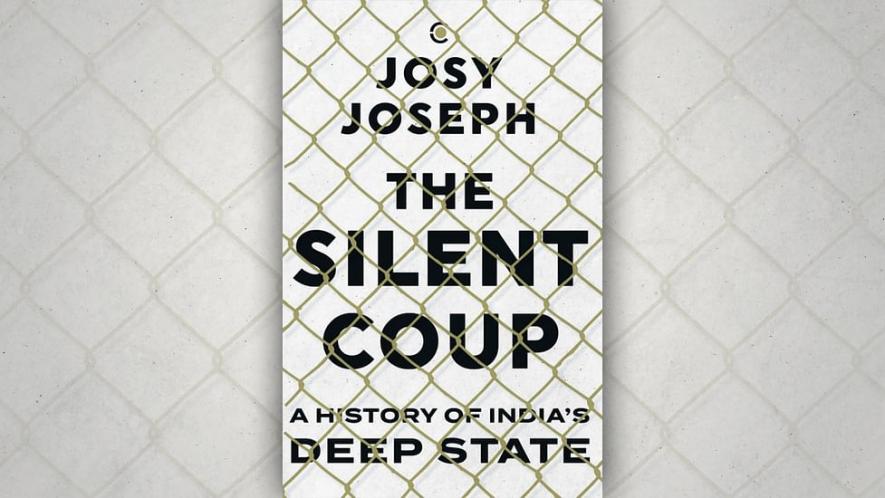Why Every Indian Must Read this Hardly Talked About Book

Image Courtesy: Newslaundry
Just as this year was about to conclude, a botched-up army operation in Nagaland has grabbed its finale. Also in this year, a book has silently appeared. While it is the best Indian non-fiction of the year, it may well turn out to be the most important book of the coming Indian decade. It is investigative journalist Josy Joseph’s The Silent Coup, the enthralling read no one is talking about.
The Silent Coup makes a crucial point when it says that the American war on terror provided cover to dozens of illiberal democracies and autocracies for a brutal crackdown on those inconvenient to them. It is masterly in outlining how this great game played out in India, whose democracy it continues to challenge at a deep-seated level.
The cloud of silence around the book after its initial welcome was punctuated once by a tweet from Bharatiya Janata Party (BJP) leader Subramanian Swamy, who remarked that the book is unique and the shadiness of the deep state is to be found the world over. But we are not the world. We are India, a nation that takes pride in excluding its defence agencies from the political galaxy. The Silent Coup reflects this heartfelt belief of every Indian against the harsh reality of the political executive silently mastering the use of non-military arms—Enforcement Directorate, Central Bureau of Investigation, Police, and Income Tax Department—to abuse democracy.
Joseph notes that he was designated to handle India-Pak affairs during his time with the online edition of The Times of India. Within days, he was approached by an acquaintance from the Intelligence Bureau who wanted to pay him a monthly retainer. The retainer was to ensure that ‘our perspective is reflected in your efforts’.
The Silent Coup not only makes you think about Haren Pandya, the BJP leader from Gujarat who sacrificed his career protecting his party. It also makes the reader exclaim about the choice the police officer Vinod Bhatt had between falsely implicating a poor man on terror charges and killing himself. Bhatt chose his dharma, and the poor man finally found freedom. Meanwhile, the thud of Bhatt’s body hitting the rail tracks beneath Dadar’s Tilak Bridge changed Mumbai at once.
The Silent Coup is highly relevant in its investigation of the dynamics between intelligence gatherers and their informants’ the world over and in their Indian chapter of maladies. The book not only helps an average Indian understand the tricky role information plays in what happened in Mon, Nagaland, earlier this month, it also shares previously unknown anecdotes that provide a macro reflection for the society and state we inhabit. For instance, on the day of the Samjhauta Express blasts, false terror accused Abdul Wahid Sheikh went to report at the Anti-Terrorism Squad (ATS) office for the daily roll call. There he found police officers distributing sweets, evidently celebrating the bombing. Joseph writes, “One former chief of an intelligence agency, who had examined the group’s [Abhinav Bharat’s] activities, said the idea was born sometime in 2003, and was, almost certainly, a creation of one of the intelligence agencies. Importantly, he also believed that the strategy was prompted by a foreign nation with which the then government had a well-publicised affinity.” One wonders, what is the current status of our relationship with this country? Further, the RDX used in the Abhinav Bharat blasts was not found to have come from army stores. Nor was the colonel, PS Purohit, “the key conspirator” in several so-called Hindutva terror cases, found to have access to these stores. So where could the RDX have come from?
In a poignant disclosure, Wahid is being taken on a SpiceJet flight when an air hostess came to him and, “as she bent to place the food tray before him, she asked softly: ‘Did you actually do the blasts?’ ‘Ma’am, can you see it written on my face? Am I a terrorist?’ Wahid asked her. She said no, and that is why she was asking him. Meanwhile, another hostess was trying to appease the policemen...” One wonders who these women were. One hopes The Silent Coup reaches them; they must get to read it.
The book notes that the government moved the Bihar regiment soldiers to surround the Golden Temple, where extremist Sikhs had holed up. “However, this was no ragtag group of Sikhs—its defences were led by Major General Shabeg Singh, one of the architects of the 1971 Bangladesh war strategy,” Joseph writes. Any reader will wonder why a hero of the Bangladesh war turned against the Indian state. Another interesting reminder of the contours of our past is when the author cites news reports of the chief secretary of Rajasthan complaining about the dead bodies of insurgents being thrown into the irrigation canals of Punjab, only to wash up in his state.
One must read the book for its sections about Kashmir and the 1987 election. Joseph notes that the “percieved myopic Gandhi-Abdullah alliance was one of the biggest political missteps in modern India”. The book discusses how in their hunt for militants, the security forces were inhuman to ordinary Kashmiris. As for militants, though they primarily targeted Hindus and the security forces, they also hunted down intellectuals sympathetic to the Indian state. Reading this one recalls Dr Shehnaz Zehra Kirmani, lecturer, Persian department, Sher-e-Kashmir University. Originally from Varanasi and married to a Persian doctorate from Lucknow, Shehnaz was shot by militants in her house on the campus in Srinagar in 1996 and died a month later in Lucknow. She had won the Kashmir University Teachers’ Association election and was pro-India. Returning to the book, Joseph points out, “The Ikhwan plan was simple. The security forces hired ex-militants, empowered them to kill and terrorise people, and then let them join politics.” A similar strategy by the deep state was deployed years later in the Naxal belt, yet again to disastrous consequences. In 2005, as Maoist violence flared, the Chhattisgarh government formed the Salwa Judum, armed it and let it loose on the local population and the Maoists.
The book is impressive in how diverse figures come together in its narration. The incarceration of Sudha Bharadwaj via “Guruji”, an influential figure who was vested with massive powers, is one such narrative. Also, the details on the intensity of cyber-attack utilised in the Bhima Koregaon case is mind-boggling and will shock cyber security professionals from the world over into silence.
What also makes this Indian journalist’s book extraordinary is that it highlights the fault lines of perception. The author points out that Sri Lanka’s Liberation Tigers of Tamil Eelam first mastered the use of suicide bombing, and they have not been surpassed so far in the number of suicide bombers they were able to produce. Similarly, he notes that the “unparalleled piece of evidence in India’s war on terror” so far is Aseemanand’s detailed statement written in Hindi and signed by him before a judicial magistrate. “This was not your usual forced confession obtained by police torture,” writes Joseph while detailing the Abhinav Bharat investigation.
Almost everyone reading this piece has at least once come across the photograph of the naked old Manipuri women asking the Indian Army to rape them. The security agencies had claimed that 32-year-old Thangjam Manorama was part of the People’s Liberation Army of Manipur. Within hours, she was abducted, raped and shot dead. It was why, five days later, a group of elderly Manipuri women demonstrated outside the Kangla Fort, the historic seat of Meitei sovreignty where the Assam Rifles has their headquarters. Similar was the case of Azad Khan. He was thrashed and shot dead in some fields near his house in full view of his family in Phoubakchao Maha Leikai village in Manipur. A year after the killing, Major Vijay Singh Balhara was named in an FIR. The FIR triggered 739 military personnel to file a petition favouring Balahra. Joseph notes that this “display of trade unionism was rare in the military”. Azad Khan was 12 years old. The book notes that after Sohrabuddin, his wife Kausar Bi, and associate Prajapati were kidnapped by the police, the state home minister was suddenly in touch with the field officers of the Crime Branch of the police. “His calls...began on 22 November [...and] dry up around 29 November, when Kausar Bi is raped and killed.”
Despite its detached narration style, the book makes one affected by the death of Justice BH Loya and his colleagues. Similarly, it makes one emotive for top bureaucrat BK Bansal and his entire family, which committed suicide. Joseph offers a casual yet chilling observation as an investigative journalist. “There was something magical in Delhi’s air as 2010 was winding up,” he begins the chapter titled Gujarat Model. “For journalists, it was the beginning of a shortlived golden period, because the mainstream media suddenly found the spine to investigate those in power and also to publish such stories. That period lasted for just about four years, until Narendra Modi, who rode to power on the back of the anticorruption and anti-government sentiments kicked up by those media reports, entered Delhi with a brutal majority and an authoritarian manner of functioning.”
The Silent Coup puts many previously half-lit events under full light and one roof. The shape that appears is so vital that this book becomes an essential handbook for every journalist, aspiring service personnel, and every lawyer, farmer and filmmaker. The book should get translated into Indian languages. Members of the Indian army and police should also read it. Only then will everyone reflect on how our country truly functions. It will make one think before believing the stories crafted by agencies and run by the media and film industry. One must speak about this book, spread the scepticism it stimulates and spread it faster than the silent firestorms that threaten to char the softness of our beloved democracy.
The author is an independent writer and film creative who lives in Mumbai. The views are personal.
Get the latest reports & analysis with people's perspective on Protests, movements & deep analytical videos, discussions of the current affairs in your Telegram app. Subscribe to NewsClick's Telegram channel & get Real-Time updates on stories, as they get published on our website.
























